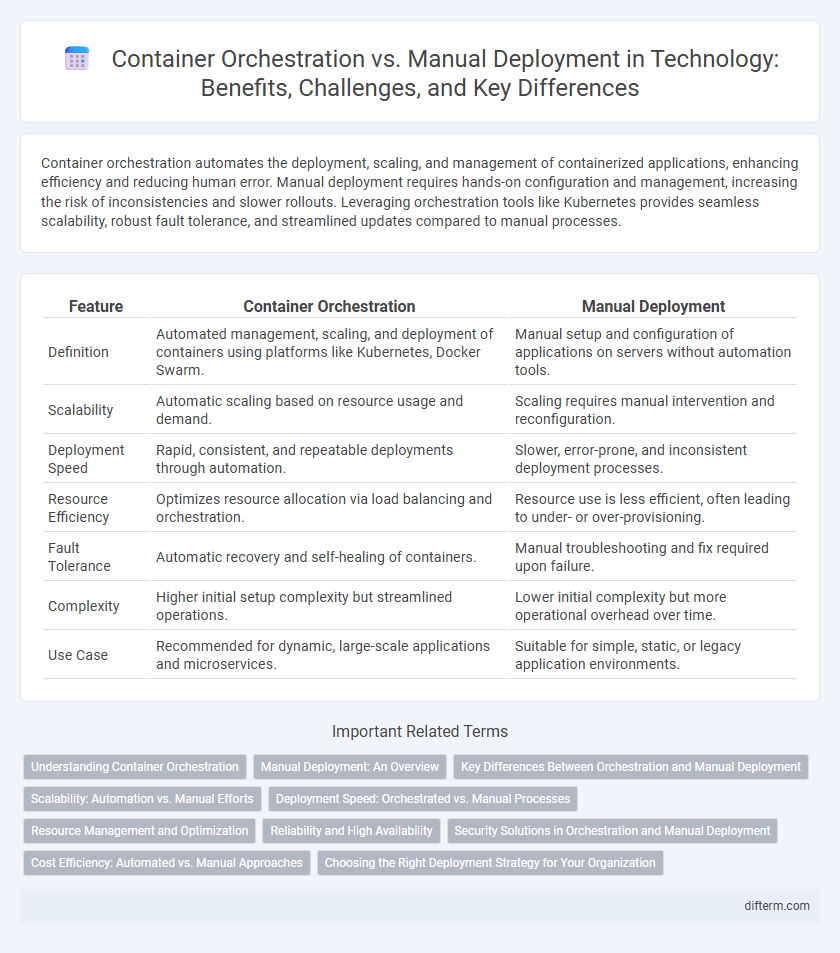Container orchestration automates the deployment, scaling, and management of containerized applications, enhancing efficiency and reducing human error. Manual deployment requires hands-on configuration and management, increasing the risk of inconsistencies and slower rollouts. Leveraging orchestration tools like Kubernetes provides seamless scalability, robust fault tolerance, and streamlined updates compared to manual processes.
Table of Comparison
| Feature | Container Orchestration | Manual Deployment |
|---|---|---|
| Definition | Automated management, scaling, and deployment of containers using platforms like Kubernetes, Docker Swarm. | Manual setup and configuration of applications on servers without automation tools. |
| Scalability | Automatic scaling based on resource usage and demand. | Scaling requires manual intervention and reconfiguration. |
| Deployment Speed | Rapid, consistent, and repeatable deployments through automation. | Slower, error-prone, and inconsistent deployment processes. |
| Resource Efficiency | Optimizes resource allocation via load balancing and orchestration. | Resource use is less efficient, often leading to under- or over-provisioning. |
| Fault Tolerance | Automatic recovery and self-healing of containers. | Manual troubleshooting and fix required upon failure. |
| Complexity | Higher initial setup complexity but streamlined operations. | Lower initial complexity but more operational overhead over time. |
| Use Case | Recommended for dynamic, large-scale applications and microservices. | Suitable for simple, static, or legacy application environments. |
Understanding Container Orchestration
Container orchestration automates the deployment, management, and scaling of containerized applications, significantly reducing manual intervention and errors compared to manual deployment. It leverages platforms like Kubernetes or Docker Swarm to coordinate container lifecycles, resource allocation, and load balancing efficiently. This approach enhances application reliability, scalability, and operational agility in dynamic cloud-native environments.
Manual Deployment: An Overview
Manual deployment involves directly managing application releases on servers without automation, which often results in higher complexity and increased risk of human error. This approach requires detailed attention to configuration settings, environment variables, and dependency management, making scalability and consistency challenging. Despite these limitations, manual deployment remains common in smaller projects or legacy systems where automation tools are not yet implemented.
Key Differences Between Orchestration and Manual Deployment
Container orchestration automates the deployment, scaling, and management of containerized applications, ensuring high availability and efficient resource utilization, whereas manual deployment requires individual configuration and scaling efforts for each container. Orchestration platforms like Kubernetes provide self-healing, load balancing, and service discovery features, which are absent in manual deployment processes. This automation reduces human error, enhances deployment speed, and supports complex microservices architectures more effectively than manual deployment.
Scalability: Automation vs. Manual Efforts
Container orchestration platforms like Kubernetes provide automated scalability by dynamically adjusting resources based on workload demands, ensuring optimal performance without human intervention. Manual deployment requires continuous monitoring and manual resource allocation, making it less efficient and prone to human error during traffic spikes. Automated orchestration reduces operational overhead and improves reliability by scaling containers seamlessly across distributed environments.
Deployment Speed: Orchestrated vs. Manual Processes
Container orchestration platforms like Kubernetes significantly accelerate deployment speed by automating resource allocation, scaling, and health monitoring, reducing manual intervention and human error. Manual deployment processes often result in slower rollouts due to repetitive configuration tasks and limited scalability, impacting overall operational efficiency. Leveraging orchestration enables continuous delivery pipelines to deploy updates swiftly and reliably across multiple environments.
Resource Management and Optimization
Container orchestration platforms like Kubernetes automate resource allocation by dynamically distributing CPU, memory, and storage based on service demand, reducing idle resource wastage and optimizing overall infrastructure efficiency. Manual deployment often leads to inconsistent resource utilization, as static configurations cannot adapt to real-time workload fluctuations, causing either over-provisioning or resource exhaustion. Automated scaling and self-healing features inherent in orchestration improve resource efficiency, enhance application performance, and lower operational costs compared to manual methods.
Reliability and High Availability
Container orchestration platforms like Kubernetes enhance reliability by automating deployment, scaling, and management of containerized applications, thus reducing manual errors and downtime. These platforms ensure high availability through features such as self-healing, load balancing, and automated failover, which maintain service continuity during failures. Manual deployment lacks such automation, increasing the risk of inconsistencies and prolonged outages in mission-critical environments.
Security Solutions in Orchestration and Manual Deployment
Container orchestration platforms such as Kubernetes offer advanced security solutions including automated policy enforcement, role-based access control (RBAC), and secure secret management, significantly reducing the risk of human error compared to manual deployment. Manual deployments lack centralized oversight, increasing vulnerabilities due to inconsistent security configurations and delayed patching of containers and host environments. Integration of security tools like vulnerability scanners and compliance auditing within orchestration frameworks ensures continuous protection and rapid incident response, surpassing manual deployment security effectiveness.
Cost Efficiency: Automated vs. Manual Approaches
Container orchestration significantly reduces operational costs by automating deployment, scaling, and management of containerized applications, minimizing the need for extensive manual intervention and associated labor expenses. Manual deployment often incurs higher costs due to increased human error, slower rollout times, and the necessity for continuous oversight and tuning. By optimizing resource utilization and enabling faster recovery from failures, container orchestration platforms like Kubernetes enhance cost efficiency compared to traditional manual deployment methods.
Choosing the Right Deployment Strategy for Your Organization
Container orchestration platforms like Kubernetes automate the deployment, scaling, and management of containerized applications, significantly reducing manual errors and operational overhead compared to manual deployment. Organizations with complex, dynamic workloads benefit from automated orchestration, facilitating faster rollouts, rollbacks, and resource optimization. Smaller teams or simple applications may still prefer manual deployment for greater control and simplicity, underscoring the importance of evaluating workload complexity, team expertise, and scalability needs when choosing the right deployment strategy.
container orchestration vs manual deployment Infographic

 difterm.com
difterm.com